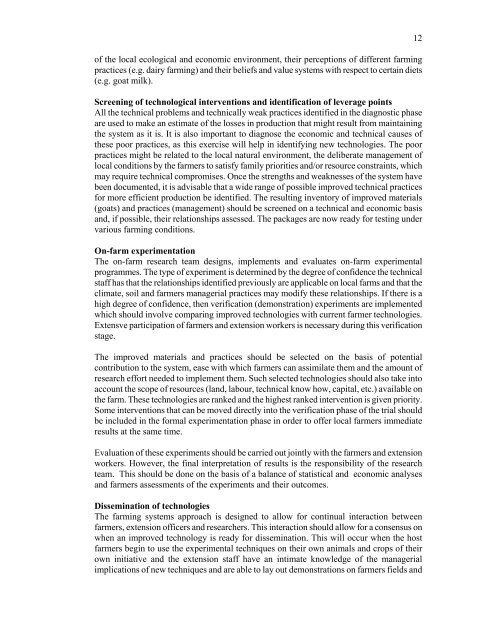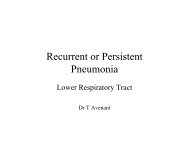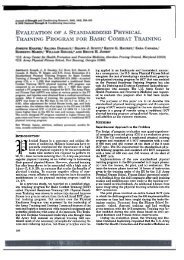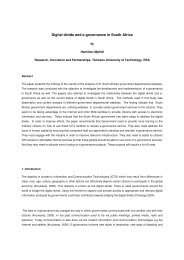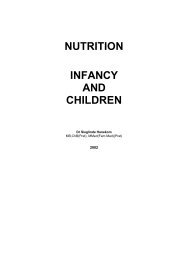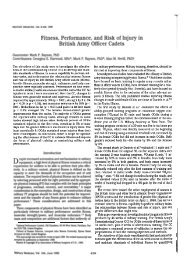Research and Training Strategies for Goat Production Systems in ...
Research and Training Strategies for Goat Production Systems in ...
Research and Training Strategies for Goat Production Systems in ...
Create successful ePaper yourself
Turn your PDF publications into a flip-book with our unique Google optimized e-Paper software.
of the local ecological <strong>and</strong> economic environment, their perceptions of different farm<strong>in</strong>g<br />
practices (e.g. dairy farm<strong>in</strong>g) <strong>and</strong> their beliefs <strong>and</strong> value systems with respect to certa<strong>in</strong> diets<br />
(e.g. goat milk).<br />
Screen<strong>in</strong>g of technological <strong>in</strong>terventions <strong>and</strong> identification of leverage po<strong>in</strong>ts<br />
All the technical problems <strong>and</strong> technically weak practices identified <strong>in</strong> the diagnostic phase<br />
are used to make an estimate of the losses <strong>in</strong> production that might result from ma<strong>in</strong>ta<strong>in</strong><strong>in</strong>g<br />
the system as it is. It is also important to diagnose the economic <strong>and</strong> technical causes of<br />
these poor practices, as this exercise will help <strong>in</strong> identify<strong>in</strong>g new technologies. The poor<br />
practices might be related to the local natural environment, the deliberate management of<br />
local conditions by the farmers to satisfy family priorities <strong>and</strong>/or resource constra<strong>in</strong>ts, which<br />
may require technical compromises. Once the strengths <strong>and</strong> weaknesses of the system have<br />
been documented, it is advisable that a wide range of possible improved technical practices<br />
<strong>for</strong> more efficient production be identified. The result<strong>in</strong>g <strong>in</strong>ventory of improved materials<br />
(goats) <strong>and</strong> practices (management) should be screened on a technical <strong>and</strong> economic basis<br />
<strong>and</strong>, if possible, their relationships assessed. The packages are now ready <strong>for</strong> test<strong>in</strong>g under<br />
various farm<strong>in</strong>g conditions.<br />
On-farm experimentation<br />
The on-farm research team designs, implements <strong>and</strong> evaluates on-farm experimental<br />
programmes. The type of experiment is determ<strong>in</strong>ed by the degree of confidence the technical<br />
staff has that the relationships identified previously are applicable on local farms <strong>and</strong> that the<br />
climate, soil <strong>and</strong> farmers managerial practices may modify these relationships. If there is a<br />
high degree of confidence, then verification (demonstration) experiments are implemented<br />
which should <strong>in</strong>volve compar<strong>in</strong>g improved technologies with current farmer technologies.<br />
Extensve participation of farmers <strong>and</strong> extension workers is necessary dur<strong>in</strong>g this verification<br />
stage.<br />
The improved materials <strong>and</strong> practices should be selected on the basis of potential<br />
contribution to the system, ease with which farmers can assimilate them <strong>and</strong> the amount of<br />
research ef<strong>for</strong>t needed to implement them. Such selected technologies should also take <strong>in</strong>to<br />
account the scope of resources (l<strong>and</strong>, labour, technical know how, capital, etc.) available on<br />
the farm. These technologies are ranked <strong>and</strong> the highest ranked <strong>in</strong>tervention is given priority.<br />
Some <strong>in</strong>terventions that can be moved directly <strong>in</strong>to the verification phase of the trial should<br />
be <strong>in</strong>cluded <strong>in</strong> the <strong>for</strong>mal experimentation phase <strong>in</strong> order to offer local farmers immediate<br />
results at the same time.<br />
Evaluation of these experiments should be carried out jo<strong>in</strong>tly with the farmers <strong>and</strong> extension<br />
workers. However, the f<strong>in</strong>al <strong>in</strong>terpretation of results is the responsibility of the research<br />
team. This should be done on the basis of a balance of statistical <strong>and</strong> economic analyses<br />
<strong>and</strong> farmers assessments of the experiments <strong>and</strong> their outcomes.<br />
Dissem<strong>in</strong>ation of technologies<br />
The farm<strong>in</strong>g systems approach is designed to allow <strong>for</strong> cont<strong>in</strong>ual <strong>in</strong>teraction between<br />
farmers, extension officers <strong>and</strong> researchers. This <strong>in</strong>teraction should allow <strong>for</strong> a consensus on<br />
when an improved technology is ready <strong>for</strong> dissem<strong>in</strong>ation. This will occur when the host<br />
farmers beg<strong>in</strong> to use the experimental techniques on their own animals <strong>and</strong> crops of their<br />
own <strong>in</strong>itiative <strong>and</strong> the extension staff have an <strong>in</strong>timate knowledge of the managerial<br />
implications of new techniques <strong>and</strong> are able to lay out demonstrations on farmers fields <strong>and</strong><br />
12


